The last climb of the last mountain stage and above the ski village of Malga Ciapela Jai Hindley and Richard Carapaz have dropped Mikel Landa. Hindley’s bridged across to his waiting team mate Lennard Kämna and now Carapaz is struggling, a gap is opening up between him and Hindley. Carapaz can’t manage his losses, he cracks and loses a minute and half on the Passo Fedaia. This was the moment Jai Hindley won the Giro d’Italia.

The race began in Hungary and despite the state of emergency huge crowds were out to see the race go past and Budapest turned pink for a day. Mathieu van der Poel won atop the Visegrad hill to take all the spoils. The next day Simon Yates showed a glimpse of his form as he stormed around Budapest to win the stage before Mark Cavendish rolled back the years to win the final Hungarian stage.

After a journey to Sicily, a stage to Mount Etna and the first GC abandon when Miguel Angel Lopez quit the race. Juan-Pedro Lopez and Lennard Kämna shared the stage’s spoils with the Spaniard starting a ten day spell in pink that would inevitably end but he finishes the Giro with 10th place, the white jersey and a bright future as a sprightly climber with a personality.
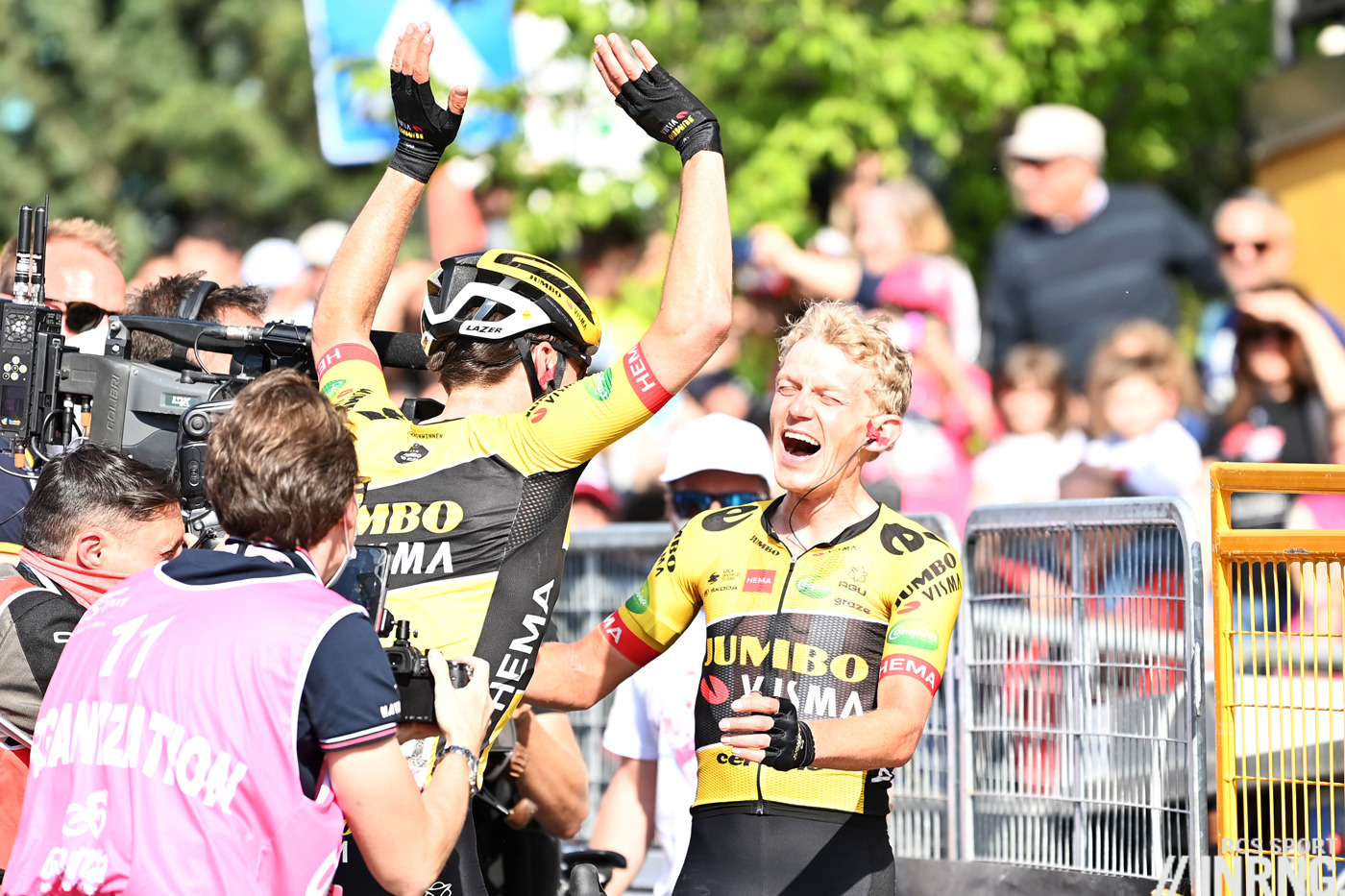
There were plenty of whispers about the Potenza stage being a hard day that could upset the overall contenders but Koen Bouwman won from the breakaway with an incisive sprint that would prove useful again for a second stage win and for racking up points to win the mountains competition. All the GC riders rolled in three minutes later.
Naples hosted a circuit race where Van der Poel launched an early attack and dragged a large group clear but he couldn’t take on the breakaway alone – he’s good, but not that good – and got countered in the finish and Thomas De Gendt won the day. There was a carpaccio of beef here with van der Poel frustrated by Biniam Girmay tracking his every move.

Days later in Jesi he could only give a thumbs up when Girmay won the stage thanks to a sublime sprint which topped off clever racecraft and effective teamwork. Girmay’s success proved his undoing, the podium prosecco cork popped into his eye and he had to leave the race. Van der Poel wanted another stage win and times you wondered what he was doing charging up the road on a hilly day but this riding helped his team mate Stefano Oldani to a stage win ,and later on he wasn’t far from a shock win in Lavarone. His refreshing presence stirred up several mountain stages and he’s now finished his first grand tour. Now he wants to finish a second in July and assuming he can recover, this aggression on any terrain makes the Tour’s green jersey competition something to look forward to.
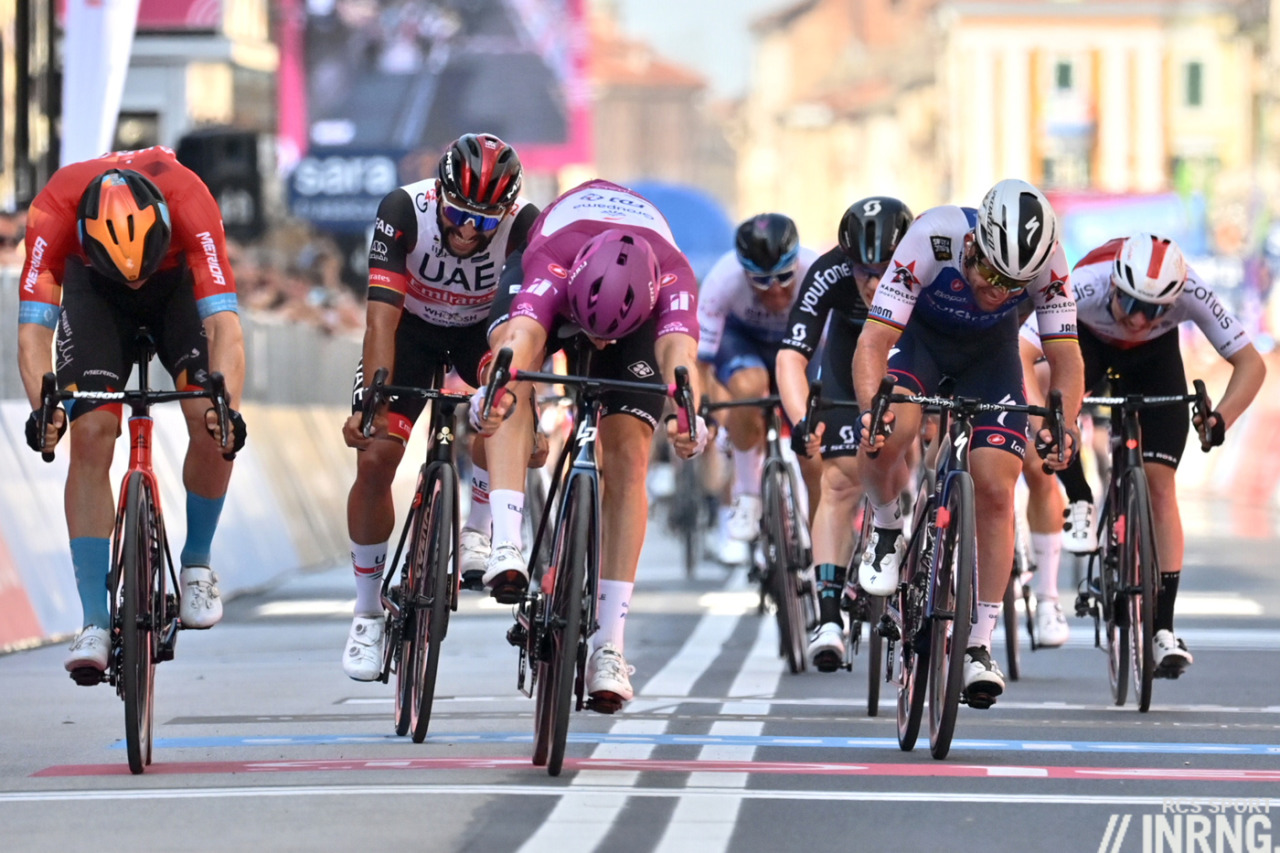
Surprisingly van der Poel barely contested the sprints. These stages weren’t always processional, with the breakaways able to put the bunch under pressure at times, Arnaud Démare won his third stage after the break was swept up in the final kilometre in Cuneo, Dries De Bondt got a stage win when the sprint trains ran out of puff. Démare proved the best but others had their chance, Alberto Dainese taking a surprise win.
Italians had plenty to cheer about. After seeing Nibali going backwards on Etna things didn’t look too rosy but stage wins for Dainese, Oldani, Ciccone and Covi provided some cheer. The state of Italian cycling matters, the sport can globalise but the largest audience for a grand tour is always at home and the local mood sets the tone.

The chart above shows the GC standings for the top four overall across the three weeks. As you can see Vincenzo Nibali is undone on Etna but for the other three, their lines are almost flat until Stage 14’s Torino circuit race and then it’s only Mikel Landa’s red line that dips. All stay practically parallel until Stage 20 and the Fedaia.
What makes a good grand tour? That should be the subject of a separate, lengthy blog post but like all good stories there should be drama and suspense. This Giro’s “fight for pink” lacked this, the Blockhaus hierarchy was maintained for some time and as lively as the Torino stage was – a candidate for a highlight of the year – the GC didn’t budge much. Mountain stage after mountain stage went by without much changing on GC. In terms of the chart above you want to see highs and lows rather than flat lines.
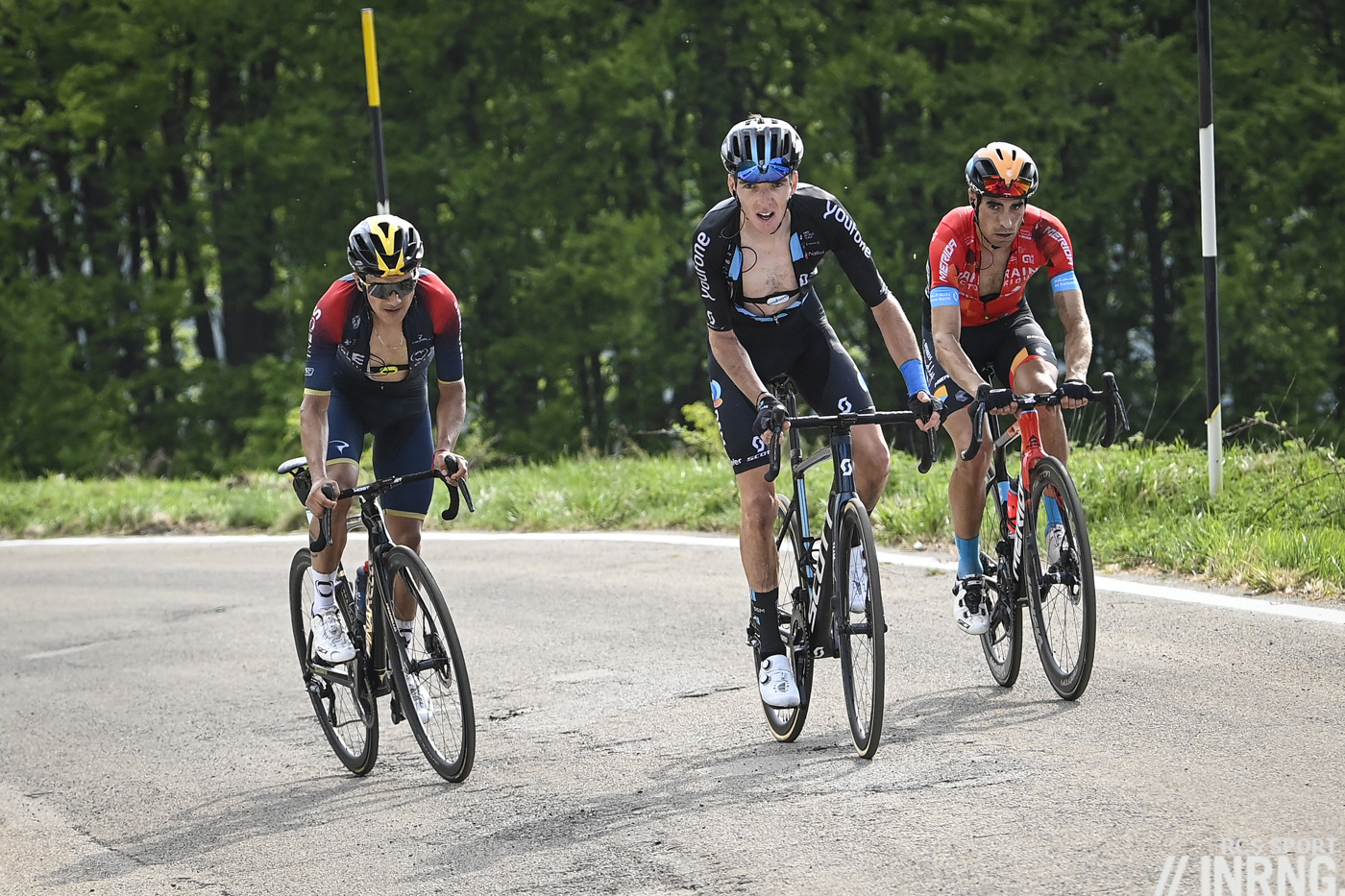
If there were hidden scriptwriters drafting the Giro’s tale, they weren’t relying on peripeteia, the drama of a protagonist seeing their fortunes rise and fall, it was all rather linear. Instead the gods deployed a different technique by writing many characters out of the plot. One or two are fine for pathos and to remind us that luck and random factors can play their part. Miguel Angel Lopez left having started in Budapest carrying an injury. In Sicily a motorbike caused a crash, Simon Yates managed to stop in time and for a second thought he’d avoided harm until a rider behind slammed into him, sending him down and his knee onto a kerbstone. Romain Bardet fell ill, likewise João Almeida while Tom Dumoulin wasn’t in the form of old. Almeida’s Covid positive is a reminder that this can and will still happen.
There can be suspense in waiting for something to happen, tension builds. But there are other forms of waiting, imagine sitting at a rural bus stop waiting for a delayed bus to show up, that’s less riveting. In this Giro it sometimes felt like the racing was suspended rather than full of suspense. However this was all relative, because as much as the Carapaz-Hindley-Landa trio proved inseparable, the rest of the field were usually where out of the picture. So this wasn’t the story of GC contenders huddling, more of three riders who, try as they might, just couldn’t shake their rivals. Yes Etna and Cogne saw a large group finishing together but things were selective on the Blockhaus, Aprica and Santuario di Castelmonte climbs, only it was just the same selection each time.
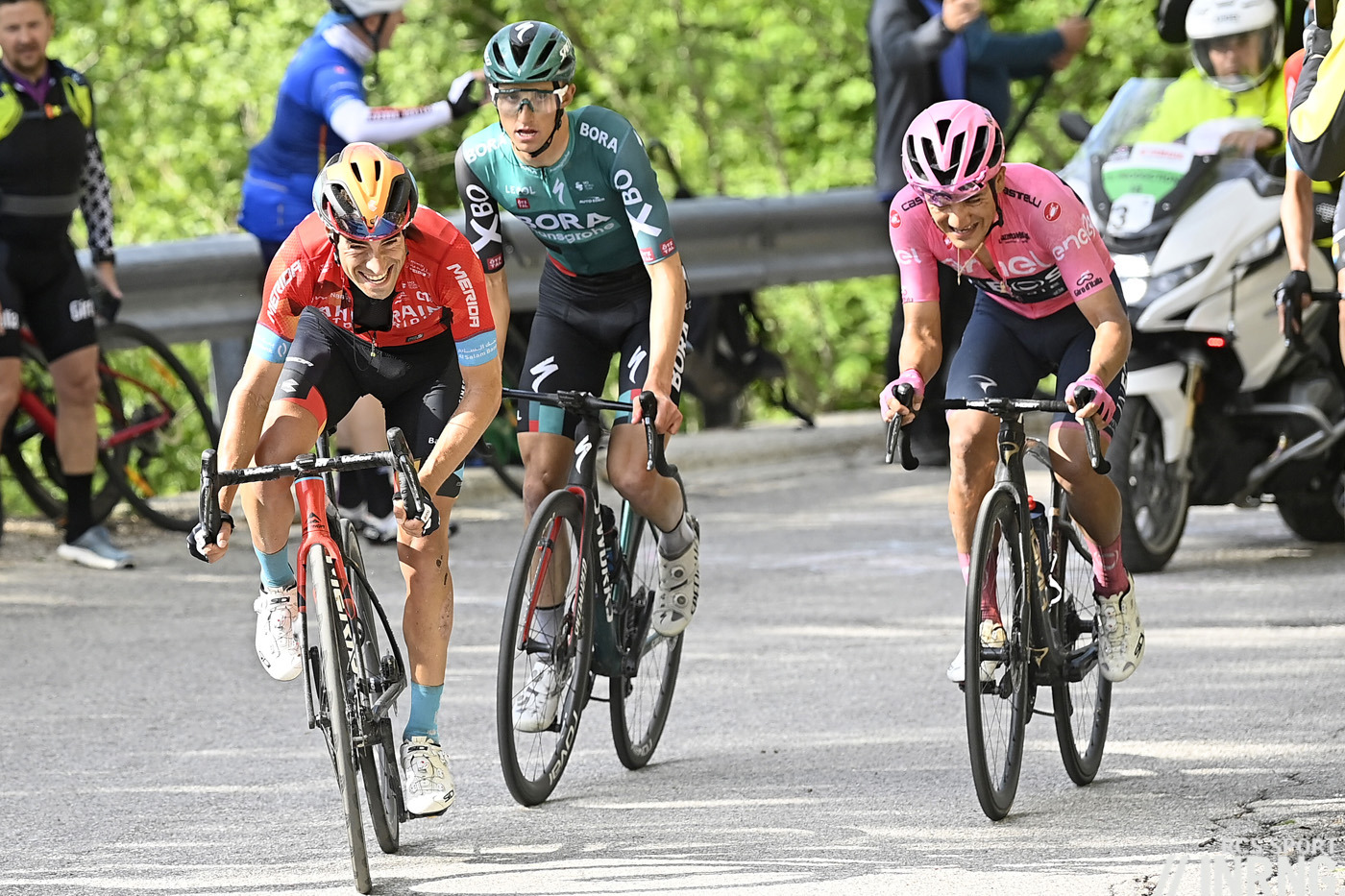
Still the course design didn’t help, one of the Giro’s luxuries is that almost anywhere it can flick off the main road to find a tricky backroad climb, thread a few of these together and you can create a hectic stage where nobody can sit still. The Torino twister is a case study, the Superga sapped the legs but the narrow roads of the Bric della Maddalena made it impossible to control. But this year’s route went for a lot of ski stations and wide strade statale arterial roads.
Still Hindley’s level line might not have been so steady were it not for João Almeida on the Blockhaus climb, the pair were among those dropped by Carapaz’s attack but Almeida never gave up and rode his way back to them, with Hindley sat on his wheel. Sure drafting is less effective on a climb of course but at the speeds they go it helps, and Almeida aside, it’s also about pacing and being able to hold a wheel counts, if there was no Almeida would Hindley have won the stage or lost time?
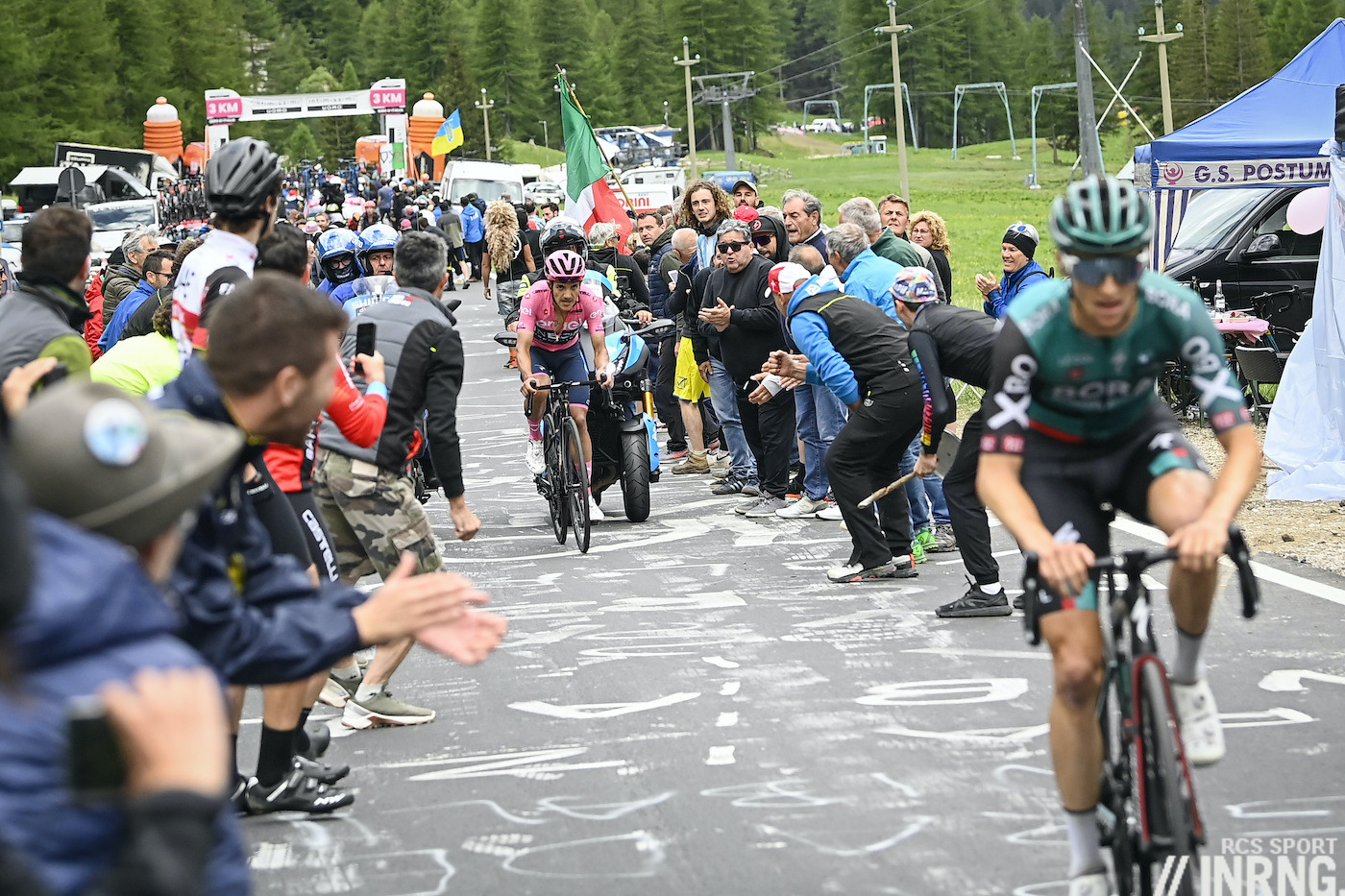
What we can be sure of is that it call came down to the Fedaia pass. As agile as Hindley looked on the climb, Carapaz imploded too. A touch of the same illness that saw team mate Richie Porte leave the race? A bug picked up from his kids who visited just before? An off-day? Or had he gone too deep just to hold the wheel and paid in cash for his oxygen debt when the Capanna Bill arrived? Whatever the explanation, he was metaphorically going backwards and soon passed by Carthy and Landa. Ironically the next day the pair were almost inseparable again in the Verona time trial, Carapaz was only seven seconds faster than Hindley.
If the GC contest never caught fire across the three weeks, none of this detracts from Hindley’s win. He beat a past winner in Carapaz who was said to be in the best form of his life, and beat him convincingly. This lends a comforting satisfaction to the result, a finality as there’s no ambiguity. Hindley didn’t sneak away for the win, he rode Carapaz off his wheel and soared on the Fedaia to take more time that many would have imagined.
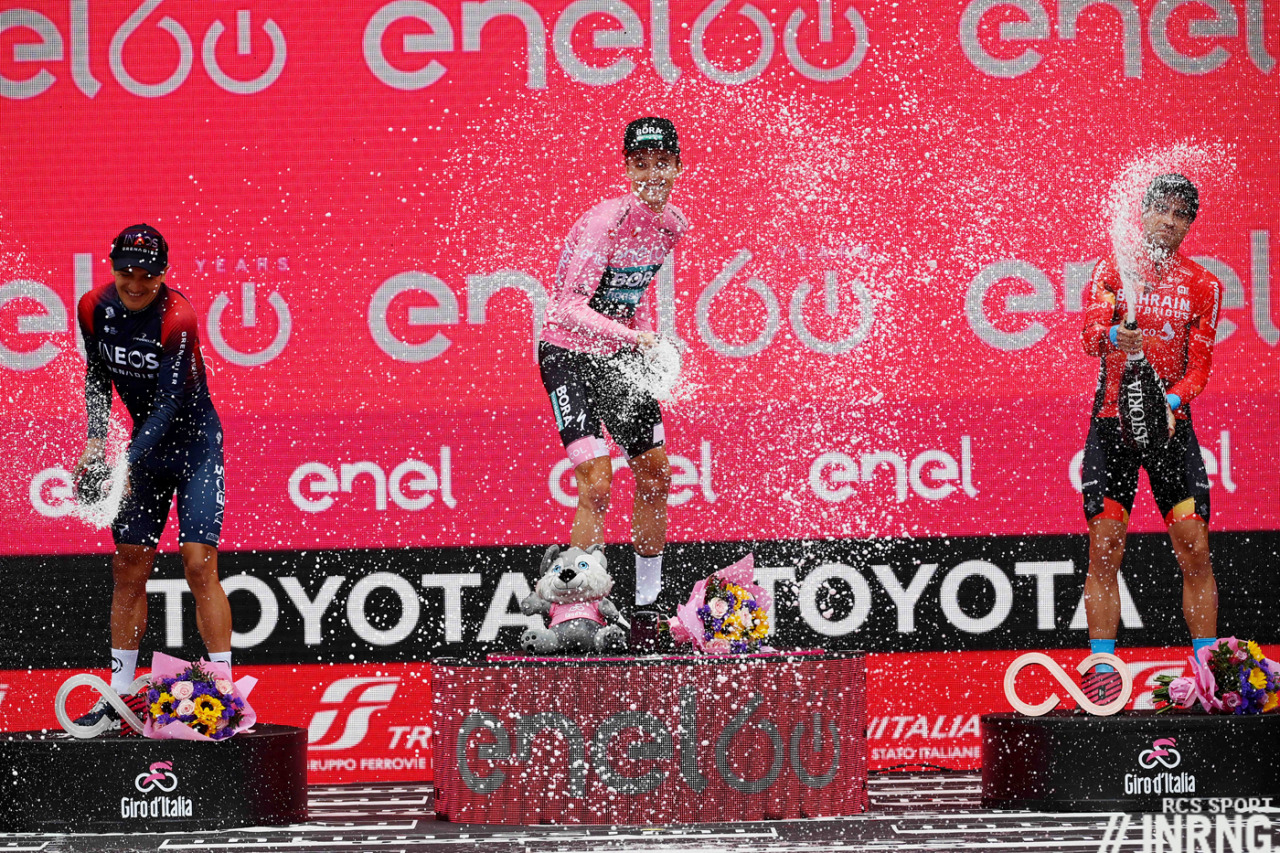
The Verdict
A victory for patience but no Aesop fable of the hare and the tortoise, two inseparable climbers rode around Italy and beyond and it was only only the upper part of the last pass on the last mountain stage that the cracks appeared. This moment though was decisive, a crack turned into a chasm for Carapaz.
After the promise of Hindley’s Giro in 2020, the following year was a flop because of crashes, injuries and infections and not his fault. Illness on the eve of Liège-Bastogne-Liège this year suggested more bad luck. But it helped Hindley fly under the radar, and perhaps even spared him because there’s every chance he could have been part of that high speed horror crash on the way to the Col du Rosier. Hindley rode a flawless race helped by a strong Bora-hansgrohe team. Not long ago the German squad was a Pro Conti team that hired Peter Sagan and expanded, now they’ve mastered the transition away from Sagan to become a stage racing team, adding the Giro to other World Tour stage race wins in Romandie and Catalunya this year, they’ll fancy their chances for a podium with Aleksandr Vlasov in July now too.
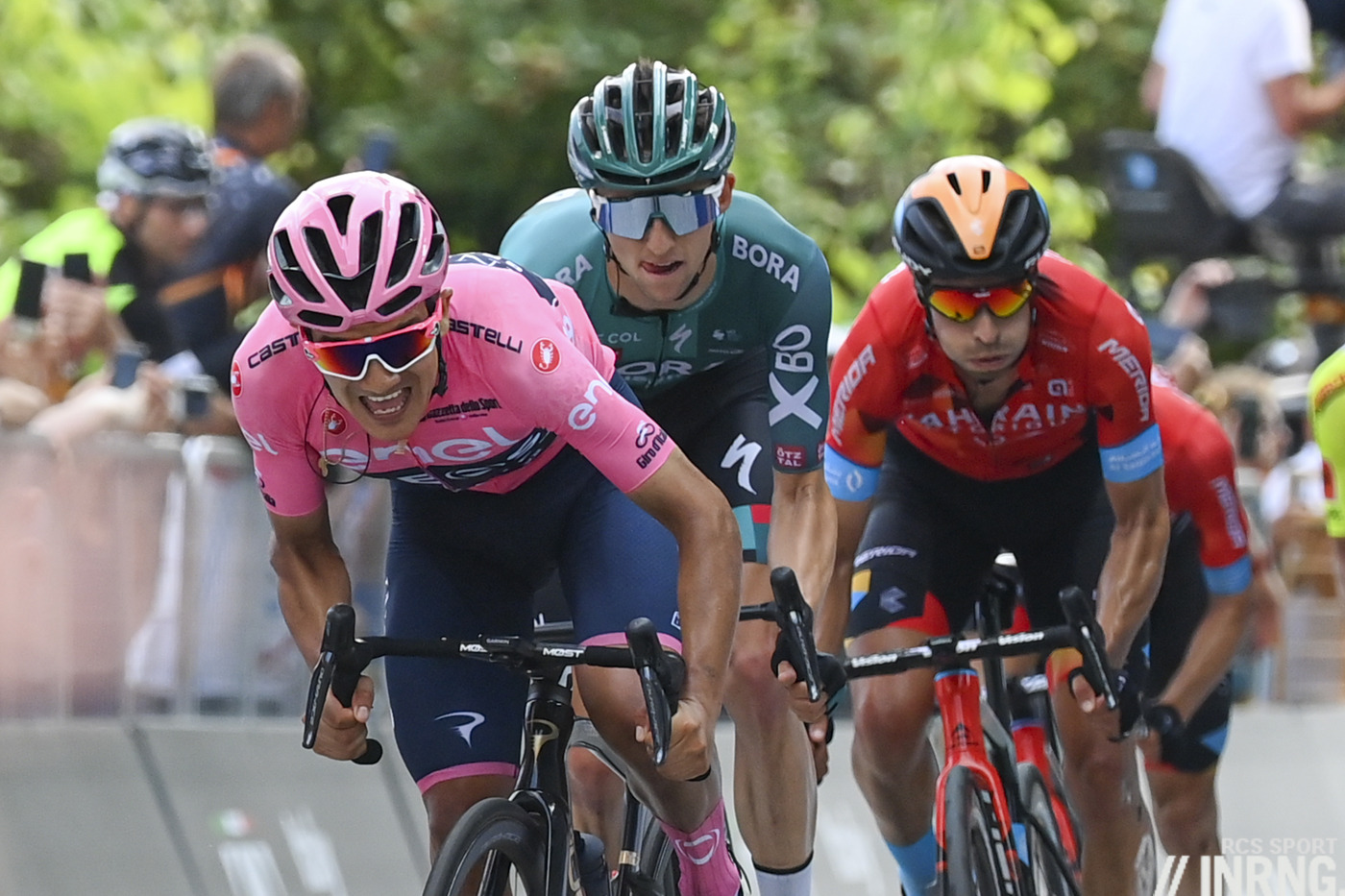
Another podium finish for Carapaz after the Tour de France and had he gone the way of Yates and Bardet then a final podium of Carapaz, Landa and Nibali could be simpatico but then the story really would have been one of abandons, his presence elevated Hindley and the podium itself. There was talk of a new Ineos during the spring classics but they rode like the Sky of old, all in for the GC and nobody trying to go for stage wins, unlike Bahrain or Bora-hansgrohe. A pity Richie Porte couldn’t make it to Verona but 20 year old Ben Tullet did with energy to spare, finishing 5th in the Verona time trial.
Landa gets his second Giro podium. As part of the inseparable trio he was further back all the time after losing time in Torino. His team did chase stage wins and got one with Santiago Buitrago and Pello Bilbao takes a solid fifth place.

Nibali’s fourth place is a fine swansong, the race’s passage through Messina was where he announced his looming retirement but he’s not done yet, he wants to finish with the late season Italian classics… and then take up mountain bike racing.
Among the other riders high on GC, Jan Hirt and Domenico Pozzovivo thrived, the former getting a stage win. Emanuel Buchmann was a stealthy seventh, if you don’t believe me see the table above. Hugh Carthy hauled himself to ninth place, overtaking J-P Lopez in the time trial.
Pro cycling often banks a result and immediately we wonder what comes next. Hindley’s certainly improved, there’s a punch and a tactical awareness now, he mastered the alchemy of presence in the front group into wins. He’s had a podium, now a win in the Giro so what can he do next? As he pleases…


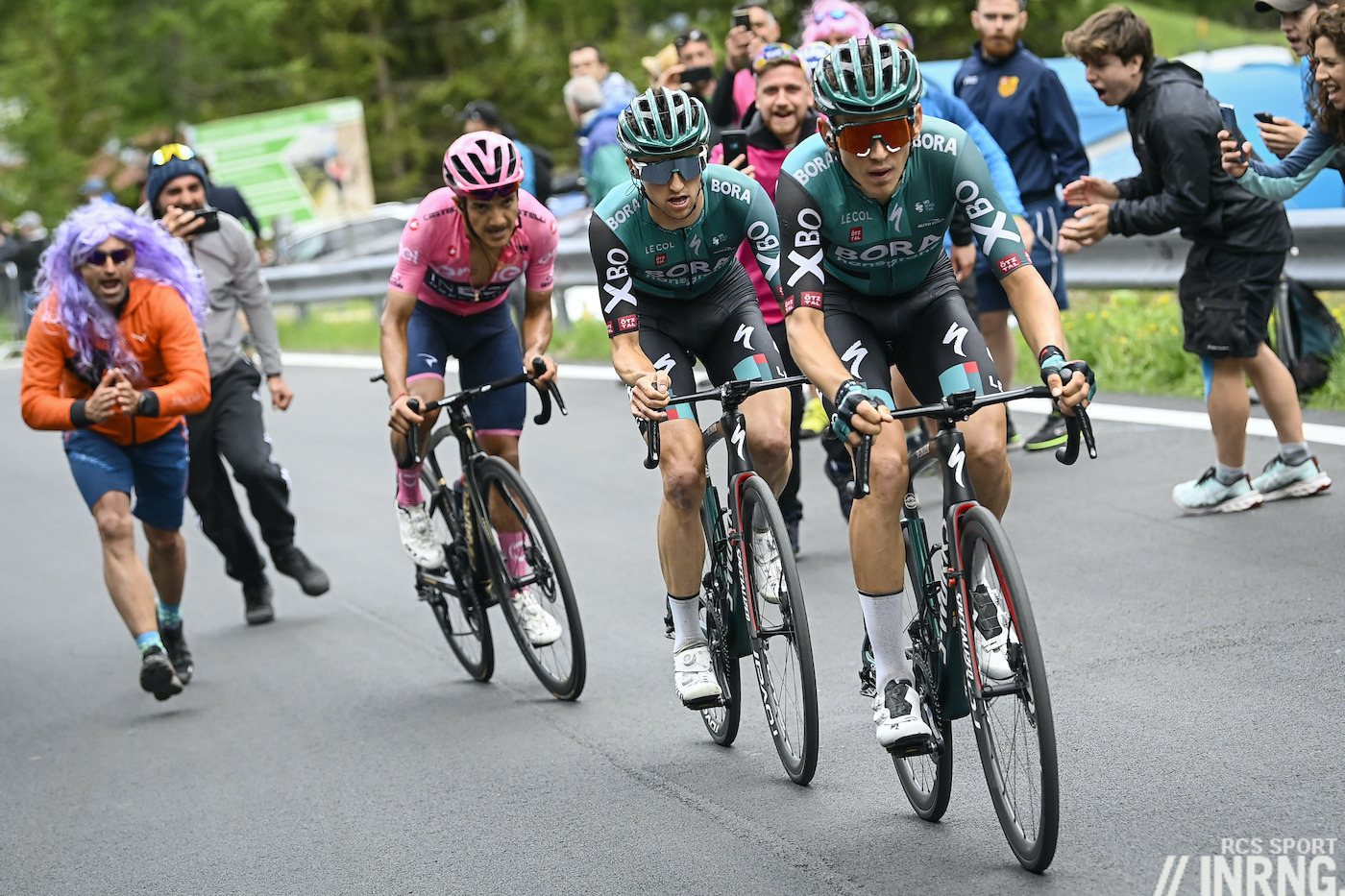
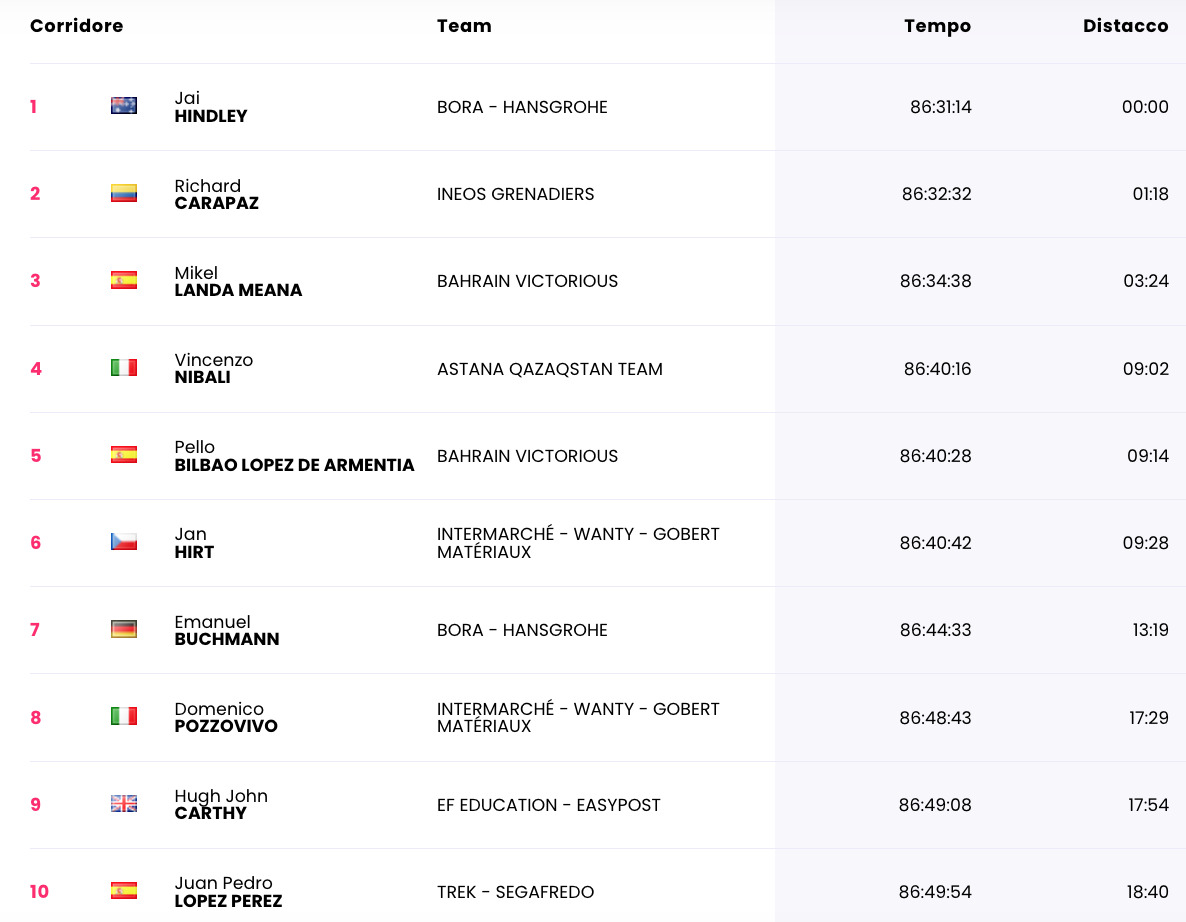
Thanks for the write up!
I enjoyed following this Giro and as always your write ups bring insights and details not often found anywhere else online.
Likewise, this blog has been a fantastic companion throughout this race and the spring classics. Can’t wait for the tour!
On the race, I really enjoyed it apart from the first week. I don’t mind seeing the break succeed day after day, it’s 2-for-1 entertainment-wise. The abandons (and the injury to Yates) were a shame given the rather thin gc field – a few more big names (pog/Rog/vernal) might have improved things, or just dominated in a boring way. It’ll be interesting to see how hindley fares at the vuelta.
Thank you so much for your insight and for being the only calm in an otherwise stormy cycling media market.
This was a great Giro but it will take a while to realise it. We have seen the steamroller that was Sky, now Ineos overturned. And it came at Jai Hindley’s second attempt to do it, when he could have been bolder first time around.
This Giro route and the way its stages were sequenced will affect the way all GTs are planned as cities start to clamour for circuits and transition stages get speed bumps in the profile.
Last, the athletes. They have opened up the whole approach to GT racing and we must learn to enjoy having so much more to focus on than just a GC clash of titans.
W il Giro
No thanks to the suggestion that all GTs will now plan their race around this route. It was good twice, in Naples and Turin, but the rest of the time it was mediocre at best and stultifyingly bad at worst.
I’m with the Ring on this. Not a vintage Giro, not even close.
Great content, good prose, valuable analysis and a very readable style. Thanks from Perth.
All the way from Perth, appreciated and can imagine you have good reasons to have especially enjoyed the Giro.
Thanks for the write ups – enjoyed every one. Long time follower and like a few here, from sunny old Perth.
Jethro
Thanks for the daily posts. It was great to hop on each day to check what was coming up & muse over the previous day’s shenanigans. That was a lot of work on your behalf. In the looking ahead column, wondering if after Bernal’s awful crash & injuries are Ineos writing off this years TdF, instead weeding through their large stable of (new) talented youngsters hoping for a Pogacar for years to come? For example I was surprised Dunbar wasn’t picked to support Carapaz on the high man stages like Sat, after he dragged C up the mtns in last year’s Tour of Switzerland. Ineos seem to be focused on the younger riders, sky train seemed missing on final climbs in Italy. Or I’m missing something/strategy/or someone.
From the Ineos team, it sounds as if Carapaz just ran out of steam on the very last climb.
That’s cruel and unfortunate for him, otherwise his TT was good enough to maintain a very slim advantage.
Thanks as ever IR.
SPIR (Senatus Populus Inner Ringus) 😀
Thank you for your amazing work, really appreciated.
One of my favourite times of the day is sitting down reading this blog.
Excellent view of the Giro, looking forward to the rest of the season, and I will be in the Alps for the tour.
Thanks for the insights and analysis from the last 3 weeks! I’m consistently surprised at how frequently your ‘chainring’ picks win the day’s stage or the overall. For example, you had Sobrero with 3 chainrings to win the final TT, even though he hadn’t won a GT TT before. That’s really good insight, I think.
Hopefully, we’ll get to do all this again in July!
Steve
‘Carapaz imploded too… Whatever the explanation’
This perfectly illustrates one of my beefs with cycling journalism. The articles only ever get written about the winner. There are hundreds of storylins at every race that never get told. Understandably the winner takes all and language barriers probably dont help but how has no one asked Carapaz his side of the story?!
Journalists can only report what they get told – there’s probably a lot of reporters wanting to ask Carapaz about why he cracked. Ineos will also put out a story that might not be 100% true – especially if it involves “methods and substances”.
Not to harp on about this, but I see Rod Ellingworth at Ineos went out and said, “It was obvious that he didn’t have his best day. He raced the final climb full gas and he ended up second. It’s as simple as that. He didn’t say anything about being in trouble. He said he felt really good. But I think afterward, he was like, ‘Yeah, I wasn’t on a great day.'” Ellingworth said also that Carapaz followed the plan for the stage. I’m not so sure about the “we did n’t know anything” and Carapaz saying he felt really good.
The moment the Giro was won, was the moment Romain Bardet got ill. He would have won at a canter.
Not sure about that but he was in good form and the podium looked be in his grasp. In a way these illnesses can go as quickly as they come so he’s and the team are probably well into thinking about the Tour de France, the original plan was to probably ride but sit down after the Giro and take stock.
Great to see the tactic of sending a man up the road to act as a bridge for an attacking GC move, actually work. And it worked to perfection. 99.9% of the time this doesn’t come off, is of no use to the GC man or has no impact on the race.
Bravo Jai Hindley and Bora – Strongest rider and beast tactics combined, took the win.
Does he go to the Vuelta now….? Terrain could be suited to another dynamic Bora team and leader.
I wonder for Hindley and the Vuelta too, not because he should or has to etc but just how he’ll do on the shorter climbs, the Giro’s climbs are often 40 minutes long, the Vuelta can be half as a rule of thumb. Hindley is looking punchier now but that punchy? Or another plan with some other races like Poland and onto Lombardia. He’s up for the Worlds in Australia of course to the plan might be that and then a calendar that works backwards from that to suit.
May also go to the Vuelta with the current thinking on how that training block sets riders up so well for the following Giro or Tour.
Just to put in a different view, the moment the race was lost was not on the final climb but when Richard Carapaz did not manage to pull away in Turin. He quickly took 30 seconds and it looked as if he was on the way to establishing a race winning lead. The thought was he would come in one minute plus on the field, which with the time bonus would put him in a pretty much impregnable position. However he couldn’t mange to finish it off. Bradley Wiggins suggested he looked nervous, constantly looking back rather than concentrating on building a lead. Little by little the chasing group pulled him back and Simon Yates took the stage. Richard Carapaz went into Pink but in reality he had not grabbed the opportunity that came his way. Difficult to imagine that Tadej Pogacar or Primoz Roglic would not have done so in similar circumstances. That would have meant a completely different scenario on the Fedaia, Ineos could have ridden to defend not to try and win there & then and fail.
It was not a particularly good edition, Turin was a good stage the rest rather lacking drama. The generally warm and dry weather meant that some of the normal Giro unpredictability was missing. No Stelvio, Agnello, Garvia, Fenestra etc meant there was no grand mountain scenery as the “high point” of the race. The Dolomites are some of the most picturesque mountains around but lack the drama of the road up to the snows of the Stelvio.
Jai Hindley has certainly flown “under the radar”, I guess many wondering if his near miss in 2020 would end up being the high point of his career. Well done to him for coming back from that to deliver the win. Where does Simon Yates go from here? I guess he will take another tilt at the Vuelta, though if rumours are true he would have a lot of competition. I suppose he can come back next year, though there will almost certainly be more TTs and possibly a Slovenian or two. Will Richard Carapaz be at Ineos beyond the end of the season, they need genuine GC shots both at the Giro & Tour and not sure he is that.
As ever many thanks the Inrng for the best cycling coverage around.
Ah, but there are often many of these what-if moments. An obvious one being Blockhaus as commented on by INRNG. In Turin, Carapaz likely burnt a few too many matches by going from so far – it’s therefore tough to know whether the others (Hindley included) were simply unable to follow, or were logically saving their energy for the climbs to come on that circuit.
I thought it interesting that Carapaz said afterwards that he was surprised that the chasers caught him. It sounded like he thought he was a lot better then he was.
Lots of “what if” moments but this was one where you could feel the momentum change in real time. Richard Carapaz rolled the dice and went long, if it had come off he would have, in all probability, won the race. However he got so far but couldnt quite break the elastic, Bradley Wiggins could see it (nothing particular to Brad, I am sure any experienced rider watching close up would have noticed the same things), Richard Carapaz probably felt it too, hence the nervousness.
This risk of attacking from fairly far out is that if it fails the advantage goes to your rivals. This sort of thing is most common in one day racing but it does happen in GTs too. Chris Froome in 2016 comes to mind, the attack from the top of the Peyresourde, and the ride a couple of days later in the crosswinds with Peter Sagan into Montpellier. He didnt gain huge time on either but he firmly established himself as leading the race, he never looked like being challenged from then on. After Turin Richard Carapaz looked vulnerable and Jai Hindley & Bora took advantage.
That’s a good point about the Turin stage, because normally when Carapaz goes nobody gets him back (see the 2019 Giro, the Tour de Suisse last year, the Olympics) and he picks his moment just when everyone else seems to need a breather. But this time I think, with the ease of hindsight, he was too ambitious, using a lot of energy and then coming to the steep “L’Inferno” climb of the Bric della Maddalena where 20 seconds can be closed by others quickly.
I think he gets caught (or nearly caught) as many times as he stays away.
Which is still pretty successful.
And I want him to keep doing it.
Yes, Torino had similarities with last year’s TdF stage 9 (I think it was stage 9), where he attacked optimistically and got closed down (by Movistar) to achieve very little time gain
THanks IR, for your passionate and clever work.
As many of you said, this was not an interesting giro. No doubt, abandons and no real TT did not help.
Have two questions for our guest and the readers of this blog, both refer to stage 20 and BV team.
Why they send a rider in the breakaway and, in sharp contrast to Bora, then send him to fight for the win?. Why they burn out Wout Poels before the fedaia?
Looking forward for the answers. Thanks in advance
To quote another website, “We’ll never know the effect it would have had if Novak had been called back to assist his team leader. Perhaps the fact that he didn’t get the order to do so tells us all we need to know about how Landa was really feeling at this point in the race.” Poels and the rest of the team hade riden on the front (for the 2nd day in a row) and were obviously following a plan which did not work.
The plan on Stage 20 was for Landa to win the stage… but he didn’t have the legs for it and so the Bahrain team gave up on it and told Novak to try his luck later on. This was info from the GIROglifici, the Giro’s official podcast.
thanks
Haven’t had the chance to post during the Giro, but thanks as always for the coverage!
Thought it was a pretty good Giro overall, especially in the first two weeks. There were plenty of great stages and intriguing battles, even if the fight for pink was a bit underwhelming on the whole.
I really believe we could have had a classic contest for the pink jersey had Yates, Bardet and Almeida stayed fit, but alas. With them out of the picture, the podium effectively sorted itself out and it didn’t help that the final kilometers of the final climb of the final stage were the hardest. This was always going to make it tempting to conserve energy for one all-out attack. Hopefully we’ll get to see a revised version of stage 20 one day, with the order of the final 2 climbs reversed (Fedaia > Pordoi). That’d lend itself far better to the kind of long range attacks that have lit up recent Giros.
As always, thanks for the coverage and for all the interesting details not covered elsewhere online.
In terms of the race, I agree that it was good but not great, and had a very worthy winner. Hope Hindley can race the Vuelta now. As has been mentioned by others, the use of time trials (longer and in the middle of the race) could have enlivened the race in terms of shifting the balance between the likes of Almeida and Carapaz/Hindley, although Almeida’s abandon perhaps renders that pointless. As an aside, the processional sprint or the short TT seems to be a feature of final days of modern GTs. Has anyone considered a World Champs-like course (Turin or Naples come to mind) that would encourage aggressive riding for anyone within a minute or two of GC? Guess it’s simply not possible in Paris, but the Giro seems more flexible. Could be a great final day spectacle on a circuit course.
A disappointment was the “Sky train” tactics of Ineos, which arguably failed them. I can see the pragmatic appeal of the single-minded approach they use, but it’s to the detriment of their non-GC riders and ultimately the team (no stages, no jerseys and no GC). Letting Porte up the road for a final crack at a GT stage (never won one, I believe) or giving an opportunity for a great young talent like Tulett to go for a stage seems to be an appealing alternative, especially when they can always drop back if the GC battle absolutely requires support (as Bora did so well on a few occasions).
As a long time lurker and very occasional commenter, I’d just like to add my name to those giving plaudits for this blog. Exceptional breadth and depth, always adding new insights, and without a trace of the snark that always seems to infest other blogs. May it long continue.
Thank you for all your hard work and input to this wonderful site.
Great write up, I enjoyed that; and all the previews – they are part and parcel of any grand tour for me now after all these years.
“Hindley didn’t sneak away for the win . . .”
I might be reading too much into that – but that was my initial impression of Carapaz’s breakthrough victory – when the ‘real’ GC hopefuls were looking at each other and paid no attention to a lieutenant going up the road, only they gave him too much time and could never get it back. But then he went on to impress in the Tour and Vuelta ( and even the Olympics) and earned his victory in my eyes. But still a gap between him and say Roglic, Pogacar and in-form Bernal and Thomas.
Why did Tao not get a chance to fight to retain/regain his title? (theory being he beat Jai once, I’m sure he is sat at home thinking maybe he could have done it again?) – bigger plans for July/September?
I did think of Carapaz’s win in 2019 and sneaking away for the win and was going to put this in the blog post but it was getting long already… but because some say this is what he did and there’s an ambiguity about it. For me, I think he stormed the stage and took a big win, to go clear on the Colle San Carlo climb like that was a big move, and then to hold off the chase on the long climb to Courmayeur. The chase did fall apart on the valley road but in part because he’d made such a bold move.
Thanks once again for the best blog in the universe Inrng. Work commitments meant that sadly I only got to watch the beautiful Budapest time trial. Your daily write ups and previews have made my breakfasts enjoyable. As such I can’t really comment too much on the racing but also wondered about Tao.
It was a no brainer for ineos to send Carapaz to the giro as the strongest ‘best of the rest’ rider. Pog showed his form in the spring classics and barring injury looks nailed on for the tour. But this leaves a couple of questions: who do they send to the tour and why not give Tao another pop at the giro?
Who knows?
Chapeau Jai
Would anyone have thought before the start that Tulett would take fifth in both the TTs. Given his non-TT physique (56kg and 1,66m according to PCS) and previous record in the Ardennes one might have expected more in the mountains – though he was riding for Carapaz – and less in the TTs. Still only 20 and what will become of him? LBL, hilly stage races or both. He appears to have coped well with the three weeks too.
A great ride. Other promising riders who did well included Leemreize, Buitrago and Arensman… who seems set to be a team mate of Tulett next year at Ineos.
GT de Fleche Wallonne. I think INEOS stay perfect in only winning GT races where stages get shortened (usually with them in the lead).
Complimenti Signore INRNG! Buon lavoro!
http://cycleitalia.blogspot.com/2022/05/thoughts-on-giro-ditalia-2022.html
Welcomme back Larry
Great writing, Larry.
One thing though: https://uxmovement.com/content/why-you-should-never-center-align-paragraph-text/
😉
Great coverage as ever so thank you. A lot more daily previews have popped up on Twitter the last few years but this blog remains the best. Mainly because it gives you some more insights than just the day’s terrain and who is likely to win
Re the GC staying largely the same for most of the race it almost makes you wish there was some way of having a bike race that almost guaranteed time gaps and make it impossible for groups to finish together on the same time. Like say if riders set off one at a time and were given the time it has taken them to finish the course individually.
But on road bikes without $2,500 skinsuits. 😉
Yates, Lopez & Bardet going home early really changed things. Shame, but that’s GT racing. Hindley was the best over 3 weeks, Carapaz nearly so (he never won a stage but did not win the GC so my forecast was nearly right!)
Thanks again for the daily info & posts. Looking forward to the Tour!
Thanks a lot for the daily info as always. This time it was much more entertaining reading your posts and previews than actually watching the race.
This Giro was won just in an athletic way. No real bike racing nor tactics nor anything. Just the stronger in the last climb won.
And that is a bit sad for the viewers. There were many stages where to deploy tactics, team work and be the smartest. But that didn’t happen for the GC.
Best blog on the web… many thanks INRNG for making another GT so much better with your daily posts, must take considerable time every day. Hugely appreciated by myself, all the other posters here and no doubt countless others.
Thanks to everyone for saying thanks, it’s appreciated.
Any feedback welcome, can be positive… but negative, critical etc is ok as well.
Stage previews for the Dauphiné next here as a warm-up for the Tour de France, but before that, time for some recon rides starting with the Stage 20 TT of the Tour de France tomorrow. There are a few missing pieces of the puzzle for the Tour to check out.
Your writing is much appreciated, as shown by your many great commentators.
What I most admire is your ability to stay on target and not get “off the rails”, staying “in the pocket” and accepting the differences in comments. This ability helps your comments to remain interesting, knowledgable, critical and polite. Leading by example – and an admirable example at that.
I have not found anything to – yet 😉 – to critise.
Very well put. Our host has many admirable traits beyond being extremely knowledgeable and a wonderful writer. Thank you from me too – the context and information from this blog, and the way it’s presented and discussed, adds immeasurably to my enjoyment of these races.
I will name 3 points were the final result was assisted. In order of occurring.
1. Blockhaus. Carapaz made an attack that distanced Hindley. Yes Hindley let almeida pace him back (a wise move if you get away with it). But notably Carapaz would not work with Landa and effectively killed the move twice.
2.Turin stage. Carapaz’s move may have had flare but was not smart. This is where not having the A team which normally goes to the tdf makes a difference. This move needed a strong team to burn off all the teamates abd reduce the group first. Without the team he needed to go later. No one reacted because they didn’t need. Wasted energy.
3. Obviously the 2nd last stage. If Carapaz had some sickness i guess we will hear about it later. But if he did why was his TT okay and why would ineous blow the field and there own team apart if Carapaz was not 100%. If Carapaz was not 100% he should have communicated it to the team like i gather Landa did. Then the team could have ridden defensively to minimise any loses.
It was an odd Giro in a lot of ways. The first weeks worth of road stages were run off at a pace roughly similar to one of Larry’s tours. You’d have to imagine that nobody, by end of first week grand tour standards, was overly fatigued by it. Then the middle third or so of the race went a bit mental with the Turin stage run at full gas and a few others where the break was hotly contested. Then it seemed when the big mountain stages came (that in retrospect possibly weren’t big enough) everyone was pooped. I think its a slight possibility that Carapaz came into the race a little well done, whereas as Hindley who had been ill just before came in under done. One went off and the other came nicely to the boil. That may be why Hindley was distanced at Blockhaus whereas later on was climbing better than anyone.
Roughly agree, but you might check better how often the first hours of each stage – normally over one hour, and often nearly two – were actually hotly contested, keeping for a very long time average speeds which were pretty much incredible, even more so on harsh, rolling or directly uphill terrains.
That happened much more often than you seem to hint above – once they were back in Italy, probably more often than any GT I’ve followed in recent years, TDF included – and I’m starting to suspect that it could have had an influence on the disappointing race attitude we had to endure.
Note that everybody is forced to keep that pace, it’s not as when the break has formed and the peloton can decide to take it easy (which they duly did a hella lot of times this edition): if you’re a captain with a strong team you just avoid the brisk accelerations and receive protection by your team, but at the end of the day you have to ride those 50-70-90 kms at that crazy speed, like it or not, until the break goes.
I watched several of those “stage incipit” because I was very curious, it’s not until very recent times that we can enjoy this option on TV and it was a part of the race which I felt I lacked experience about (of course, you read about it, may listen to the race radio, and even have an idea by the minor races one might have tackled, but all the above isn’t as actually watching it with helis and motos etc.)
In that sense, Diamante-Potenza (first week) was absolutely unbelievable to watch, but – for different reasons, not exactly the above mentioned one, rather the course itself or strategy – also the Blockhaus stage and Naples had a pretty brisk pace at the beginning, just as Messina went frantic from the climb on.
And it also became more common later on, maybe partly because of a sort of MDVP effect, stirring up things.
OTOH, of course most of the intermediate climbs were often tackled at a very low pace by the peloton, which became really terrible when things became serious. The numbers on San Pellegrino, Crocedomini and to an extent even Mortirolo, Kolovrat or Pordoi are quite depressing, not to speak of my dear Montagna Grande di Viggiano.
Very pleased for Hindley from Australian perspective and will be interested to see if he has any improvement left in him. Apart from that I am always impressed by a good time trial ride and Sobrero delivered in spades.
This Giro was ok. Apart from the droputs, what killed it for me was the midweek lull and the lack of any “fight for pink”. Once someone who was decent but not a real threat for the win got the jersey, the big boys were happy to let them keep it for a while. I think if there had been a few leader changes, even if just token ones, in that second week it would’ve been a bit more exciting.
Thanks for the insights INRNG. Much appreciated.
It was refreshing to see Cofidis and VD Poel going up the road so often simply because they threw the script out of the window. Time for the ageing INEOS trains to be stabled. They don’t have either the quality or depth of riders any more and well engineered ski roads only serve to eject the weaker riders and leave their leader unprotected at vital points.
Overal, a generally disapointing course with a couple of notable exceptions given the all the potential in Italy.
The best rider won!
In 1952 3 Australians (for the first time) took part in the Giro and none of them managed to finish the race. 70 years later Jai Hindley is a worthy winner, well done mate!!!
P.S. Mr Ring thank you for the great coverage!
Thank you for a detailed balanced insightful entertaining write up for the last 3 weeks.
I love the Giro . Its my favourite race of the year . I particularly loved Allesandro de Marche going off the front of the group to salute fans in his home town , even stopping to embrace his young child and on the side of the road.
I also loved the sprint stage where Ewan and Can got dropped on the mid stage climb and could not come back,
The first time trial was riveting .
Biniam Girmay stage win will go down in history
The stage around Turin was fantastic.
The stage in Napoli was also Great
All in all it was a great Giro
Did I mention that I am an Aussie and I loved the fact that Jai won ?
Thank you for livening up yet another Grand Tour Mr Ring.
You continue to amuse, delight and astonish with your immaculately crafted words (except for the spelling mistakes of course 😉 )
Mille thanks.
An that last picture is pure gold.
Mille thanks.
And that last picture is pure gold.
Of course Carapaz and Landa will regret having let Hindley come back on the Blockhaus. Eliminate when you can is the motto of GT riders. But in the end the race was won by being the best climber. A GT shouldn’t be reduced to a climbing contest.